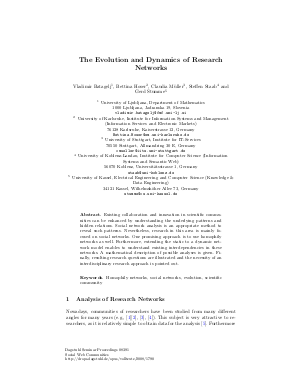08391 Group Summary – The Evolution and Dynamics of Research Networks
Authors Vladimir Batagelj, Bettina Hoser, Claudia Müller, Steffen Staab, Gerd Stumme
-
Part of:
Volume:
Dagstuhl Seminar Proceedings, Volume 8391
Part of: Series: Dagstuhl Seminar Proceedings (DagSemProc) - License:
 Creative Commons Attribution 4.0 International license
Creative Commons Attribution 4.0 International license
- Publication Date: 2008-12-22
File

PDF
DagSemProc.08391.5.pdf
- Filesize: 261 kB
- 8 pages
Document Identifiers
Subject Classification
Keywords
- Homophily networks
- social networks
- evolution
- scientific community
Metrics
- Access Statistics
-
Total Accesses (updated on a weekly basis)
0PDF Downloads0Metadata Views
Abstract
Existing collaboration and innovation in scientific communities can be enhanced by understanding the underlying patterns und hidden relations. Social network analysis is an appropriate method to reveal such patterns. Nevertheless, research in this area is mainly focused on social networks. One promising approach is to use homophily networks as well. Furthermore, extending the static to a dynamic network model enables to understand existing interdependencies in these networks. A mathematical description of possible analyses is given. Finally, resulting research questions are illustrated and the necessity of an interdisciplinary research approach is pointed out.
Cite As Get BibTex
Vladimir Batagelj, Bettina Hoser, Claudia Müller, Steffen Staab, and Gerd Stumme. 08391 Group Summary – The Evolution and Dynamics of Research Networks. In Social Web Communities. Dagstuhl Seminar Proceedings, Volume 8391, pp. 1-8, Schloss Dagstuhl – Leibniz-Zentrum für Informatik (2008)
https://doi.org/10.4230/DagSemProc.08391.5
BibTex
@InProceedings{batagelj_et_al:DagSemProc.08391.5,
author = {Batagelj, Vladimir and Hoser, Bettina and M\"{u}ller, Claudia and Staab, Steffen and Stumme, Gerd},
title = {{08391 Group Summary – The Evolution and Dynamics of Research Networks}},
booktitle = {Social Web Communities},
pages = {1--8},
series = {Dagstuhl Seminar Proceedings (DagSemProc)},
ISSN = {1862-4405},
year = {2008},
volume = {8391},
editor = {Harith Alani and Steffen Staab and Gerd Stumme},
publisher = {Schloss Dagstuhl -- Leibniz-Zentrum f{\"u}r Informatik},
address = {Dagstuhl, Germany},
URL = {https://drops.dagstuhl.de/entities/document/10.4230/DagSemProc.08391.5},
URN = {urn:nbn:de:0030-drops-17906},
doi = {10.4230/DagSemProc.08391.5},
annote = {Keywords: Homophily networks, social networks, evolution, scientific community}
}
